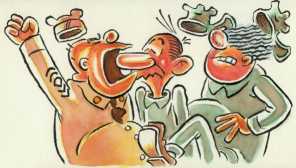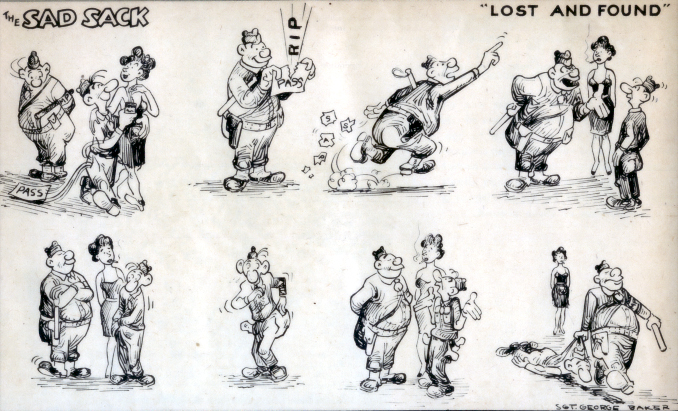George Baker - Creator of Sad Sack
May 22, 1915 - May 5, 1975.
 After an inauspicious start to his working life, in 1937 George Baker went to Hollywood to work for Walt Disney. For the next four years he worked on virtually all of Disney's well known pictures which included Pinocchio, Fantasia, Dumbo and Bambi. From there he was inducted into the army in June of 1941.
After an inauspicious start to his working life, in 1937 George Baker went to Hollywood to work for Walt Disney. For the next four years he worked on virtually all of Disney's well known pictures which included Pinocchio, Fantasia, Dumbo and Bambi. From there he was inducted into the army in June of 1941.
Like many young men in 1940s America, Baker found himself a member of the U.S. Army. And like most, he didn't much care for it. His frustration with Army life found expression in a series of drawings he made for his own amusement, about an unlucky, unhappy draftee's response to his new situation. He entered one of them in a contest, and won. The cartoon was published in Life magazine in 1941, and that's how Sad Sack first saw print.
When the U.S. entered World War II, Baker, unlike most soldiers, stayed in America, assigned to work on the Army's new Yank magazine (which also published early work by Bil Keane, creator of The Family Circus, and where Dave Breger was soon to give the world the term "G.I. Joe"). The magazine's editor, Major Hartzell Spence, had seen Baker's drawing in Life, and made Sad Sack a regular feature. Despite occasional grumbling from officers, the strip was very popular among the rank and file, and achieved favorable notice in the civilian press as well. There was even a short-lived radio show, in which Mel Blanc, voice of Bugs, Daffy and so many others, played Sack.
 Sad Sack's name is a shortened form of a scatological phrase denoting a pathetic loser, one of many popular slang expressions in the then-all-male Army which, at the time, were not considered proper language for mixed company. And that's not the only risque factor in the early Sack - in addition to the usual kitchen duty and unjust treatment by superiors, Sack watched sexual hygiene films, consorted with loose women, and did any number of other "improper", yet very soldier-like things. But sexual suggestiveness was common among cartoon characters seen only by military men during World War II, such as Private Snafu and Miss Lace.
Sad Sack's name is a shortened form of a scatological phrase denoting a pathetic loser, one of many popular slang expressions in the then-all-male Army which, at the time, were not considered proper language for mixed company. And that's not the only risque factor in the early Sack - in addition to the usual kitchen duty and unjust treatment by superiors, Sack watched sexual hygiene films, consorted with loose women, and did any number of other "improper", yet very soldier-like things. But sexual suggestiveness was common among cartoon characters seen only by military men during World War II, such as Private Snafu and Miss Lace.
A Sad Sack cartoon strip is shown below, which embodies the typical character of the hapless GI.

All Artworks Copyright © Jack Coggins